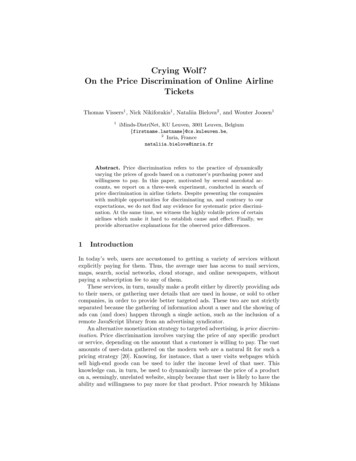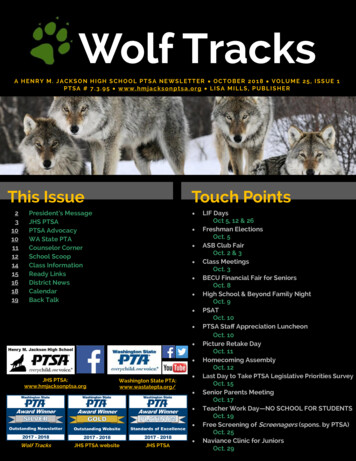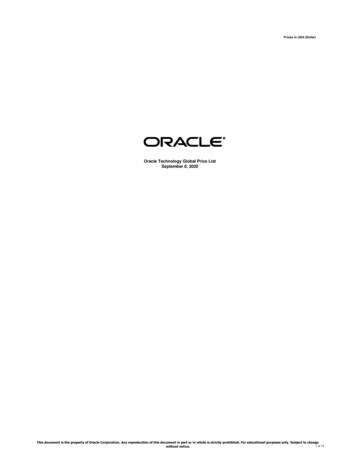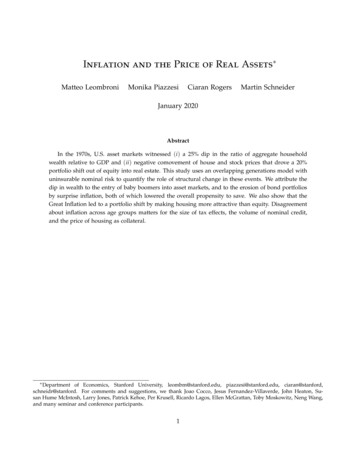
Transcription
Crying Wolf ?On the Price Discrimination of Online AirlineTicketsThomas Vissers1 , Nick Nikiforakis1 , Nataliia Bielova2 , and Wouter Joosen11iMinds-DistriNet, KU Leuven, 3001 Leuven, Belgium{firstname.lastname}@cs.kuleuven.be,2Inria, Francenataliia.bielova@inria.frAbstract. Price discrimination refers to the practice of dynamicallyvarying the prices of goods based on a customer’s purchasing power andwillingness to pay. In this paper, motivated by several anecdotal accounts, we report on a three-week experiment, conducted in search ofprice discrimination in airline tickets. Despite presenting the companieswith multiple opportunities for discriminating us, and contrary to ourexpectations, we do not find any evidence for systematic price discrimination. At the same time, we witness the highly volatile prices of certainairlines which make it hard to establish cause and effect. Finally, weprovide alternative explanations for the observed price differences.1IntroductionIn today’s web, users are accustomed to getting a variety of services withoutexplicitly paying for them. Thus, the average user has access to mail services,maps, search, social networks, cloud storage, and online newspapers, withoutpaying a subscription fee to any of them.These services, in turn, usually make a profit either by directly providing adsto their users, or gathering user details that are used in house, or sold to othercompanies, in order to provide better targeted ads. These two are not strictlyseparated because the gathering of information about a user and the showing ofads can (and does) happen through a single action, such as the inclusion of aremote JavaScript library from an advertising syndicator.An alternative monetization strategy to targeted advertising, is price discrimination. Price discrimination involves varying the price of any specific productor service, depending on the amount that a customer is willing to pay. The vastamounts of user-data gathered on the modern web are a natural fit for such apricing strategy [20]. Knowing, for instance, that a user visits webpages whichsell high-end goods can be used to infer the income level of that user. Thisknowledge can, in turn, be used to dynamically increase the price of a producton a, seemingly, unrelated website, simply because that user is likely to have theability and willingness to pay more for that product. Prior research by Mikians
et al. [17] showed that price discrimination is used to vary the prices of digitalproducts (such as ebooks) based on the geographical location of the user. Theauthors later showed that crowdsourcing can be used to unearth harder-to-findcases of price discrimination, such as the ones present in regional e-shops [18].In this paper, motivated by several anecdotal reports [7,14,23], we investigatewhether airlines practice price discrimination on the tickets sold through theirwebsites. Airline tickets are an attractive target for price discrimination due tothe highly volatile nature of their prices. An airline could, for instance, recognizethe same user over time, e.g., through the use of cookies, and gradually increasethe price of a specific ticket. The user is likely to attribute the price increase toflight congestion (many people buying tickets for that specific flight) and buythe ticket at an increased price, out of fear that the price will increase even more.Through a three-week long experiment, involving 25 different airline companies, we find that, at this time, airlines seem not to be employing any systematicprice discrimination. While we did observe some price fluctuations that couldbe interpreted as due to discrimination, in most cases, these fluctuations couldbe explained through other means, e.g., increased tax on tickets of a regionalairline, when those were purchased outside of that specific region. At the sametime, we show how difficult it is to establish cause and effect for airline pricesand we make available the set of prices that we collected so that it can be usedon future research on the topic of price discrimination [24].22.1BackgroundUser TrackingSome of the strategies that could be of use in price discrimination require thetracking of users between page loads of the same site, as well as across differentwebsites.Browser cookies have emerged as the de facto way of tracking users in themodern web. The cookie mechanism allows a web server to store a small amountof data on the computers of visiting users, which is then sent back to the webserver upon subsequent requests. Cookies can be separated in first-party andthird-party depending on the way on which they are set and read.First-party cookies are cookies set by the website that the user is consciouslyvisiting, e.g., a user visiting the website of Delta Airlines and receiving cookies forthe delta.com domain. First-party cookies are used to, among others, maintainstate over the stateless HTTP protocol, and recognize visitors between pageloads.Third-party cookies are cookies given by third-party servers which providecontent to a first-party page. If, for instance, Delta airlines uses a Facebook“Like” button, Facebook has the ability to store and read cookies when thevisitor visits the delta.com website. Third-party cookies are more intrusive thanfirst-party cookies, since they can be used to track users in a cross-site way [12,22]. If for instance, the sites travel.com and football.com show ads from the
same advertising syndicator, that syndicator has the ability to correlate usersbetween these sites and build a browsing profile for each user that can be thenmonetized in series of ways, including targeted ads and the selling of a user’sinformation to larger data aggregators and brokers.Next to cookies and other techniques involving the storing of identifiers at theclient-side [15], web-based device fingerprinting is another technology that hasrecently emerged and can also be used to track users. In fingerprinting, severalattributes of a user’s browsing environment, e.g., a user’s browser, platform,screen dimensions, and installed plugins, can be combined to form a fingerprintthat is, for all practical purposes, unique [5,9,19]. The advantage of fingerprintingis that it is stateless and, because of that, hidden from a user, i.e., no cookies toinspect or delete.2.2Anecdotal Evidence of Price DiscriminationOver the past years, many articles, blog posts and Internet fora have reportedthe use of price discrimination in online travel tickets. Generally, these claims arebased on anecdotal evidence. In this section, we briefly list several noteworthycases and discussions.In 2011, a massively “retweeted” tweet [23] implied that Ryanair was tracking users through cookies and raising their prices based on the user’s previousvisits. On a blog post that followed [7], similar claims were made by people entering the discussion: TheTrainline.com, Expedia, Easyjet, Virgin, Lastminuteand Eurostar were all accused of price discrimination based on previous visitsor search queries. The Wall Street Journal reported a year later that Orbitz [3],an online travel agency (OTA), presents Apple-branded computers with moreexpensive flight and hotel search results first [14], a practice that is referred toas search discrimination [17].In 2013, a column published in USA Today [16] specifically discussed thecurrent technical possibilities and legal implications of price discrimination inthe travel sector. Furthermore, they claim to have observed a price differencewith a cookie-cleared browser in tests they conducted in 2007.More recently, in January 2014, a blogger explained how he got a less expensive fare from Kayak [2], a travel metasearch engine, by using a Canadianinstead of an American IP address [6].3Large-scale analysisAs noted in the previous section, airline companies have been accused of servingdifferent prices according to a client’s geographical location, the device theyuse, their consumer profile or their previous search queries. We evaluate thisclaim by analyzing 25 airlines continuously for 3 weeks, with dozens of uniqueuser profiles. These profiles are constructed in light of the user-tracking methodsexplained in Section 2.1, and the potential discriminating factors.
To properly assess these practices, we emulate real users performing searchqueries for specific flight routes. We do this repeatedly for all the different userprofiles on all regarded airlines. For every conducted search query, we keep trackof the prices that are presented to that particular user.In the following paragraphs, we will explain the techniques used to automatethe search queries and to construct different user profiles.3.1Automated search queryingDuring 21 days, we queried 25 airlines twice a day, with 66 user profiles, fromtwo different geographical locations simultaneously resulting to a total of over130,000 queries. We automated this large-scale analysis by building a scraperusing CasperJS [1], which is a navigation scripting and testing utility for PhantomJS [4], a headless browser. We ensured our scraper followed the exact samesteps a normal user would follow when manually searching for airline tickets. Thescraper ran from January 15, 2014 until February 5, 2014, querying for flightsdeparting on March 22, 2014 and returning on March 30, 2014. The specific flightroutes that were queried were different for every airline, but fixed throughoutthe entire analysis. The order in which the scraper iterated the 66 user profilesfor every airline was randomized at each run.3.2Constructing user profilesWe constructed a total of 66 unique user profiles, which are the result of combining several different subprofiles, described in the following sections. The majority of these leveraged the ability of PhantomJS to easily configure the browser’sinternals and cookie settings. Additionally, two geographical subprofiles werecreated, which were both combined with the 66 user profiles.Browser and OS profiles The browser and operating system (OS) profiles areset up to observe potential discrimination based on the user’s device. From a webserver’s perspective, the User-Agent string is the most straightforward feature foridentifying the client’s Internet browser and OS. When making a web request,the client sends this string as an HTTP header to the web server. Moreover,the User-Agent string also resides in the browser’s navigator Javascript-object,together with other indicative strings, such as vendor, platform, appCodeName,appName and appVersion. A web server can use this information to determinewhich browser and OS a particular client is using. For example, the User-Agentstring of Safari Mobile running on an iPad with iOS 4.3.5 is easily recognized:Mozilla/5.0 (iPad; U; CPU OS 4 3 5 like Mac OS X; en-gb)AppleWebKit/533.17.9 (KHTML, like Gecko) Version/5.0.2Mobile/8L1 Safari/6533.18.5By spoofing the information in the User-Agent string and the navigator object, we were able to mimic different OSs and browser profiles. Our scraper was
programmed to emulate several different profiles: Internet Explorer 9 on Windows 7, Chrome 29 on Windows 7, Firefox 22 on OS X 10.7, Safari 6 on OS X10.7 and Safari Mobile 5 on iOS (iPad).Furthermore, we configured additional Chrome, Safari and Internet Explorerprofiles with the Do Not Track (DNT) header set to 1. The DNT header is anHTTP header which can be utilized by users to request from a web applicationto disable their tracking [25].Consumer profiles Inspired by the study of Mikians et al. [17], we designed3 consumer profiles: affluent, budget and flight comparer. These profiles werecomposed by gathering cookies of websites that can be associated with them.For example, the cookies for the affluent profile were gathered by visiting sitesassociated with luxury goods and financial news. For the budget profile, wecollected cookies from websites offering discounts and product reviews. And forthe travel comparer profile, online travel agencies and travel metasearch engines,such as kayak.com, were included.For each profile, we kept a separate cookie jar : all cookies gathered by aparticular consumer profile were saved in an isolated file. When a consumer profile needs to be instantiated, its cookie jar can simply be loaded in PhantomJS.This way, potential third-party trackers, could access the consumer profile cookies while our crawlers visited the website of each airline.Cookie setting profiles As discussed in Section 2.1, websites can make use offirst-party and third-party cookies to track users between loads of the same pageand across different websites. In our experiment, we accounted for four differentcookie settings, when gathering ticket prices for each airline:––––Only consumer profile cookies (gathered in advance)Consumer profile cookies along with first-party cookiesOnly first-party cookies (also known as no third-party cookies)No cookiesIn our experiments, the first-party cookies are the cookies set by the airlinesthemselves which can be used to track a user’s previous visits and searches andpotentially influence the prices shown to users over time.Geographical profile Websites often resort to the user’s IP address as anindicator of locality [6, 17]. In order to set up different geographical profiles, thescraper ran simultaneously from two different locations, one in New York, UnitedStates and one in Leuven, Belgium.3.3HypothesisIn order to evaluate the presence of systematic price discrimination, we testfor the following hypothesis: if airlines present unequal prices to different users
according to their consumer profile, location, or browsing history, we should beable to observe this when comparing the prices presented to a set of emulatedusers that differ in those characteristics, over several points in time. For instance,if a company is presenting higher prices to users of Apple products, a time-seriesgraph of ticket prices should place our emulated Apple user “above” other users.3.4Limitation
the ticket at an increased price, out of fear that the price will increase even more. Through a three-week long experiment, involving 25 di erent airline compa-nies, we nd that, at this time, airlines seem not to be employing any systematic price discrimination. While we did observe some price uctuations that could be interpreted as due to discrimination, in most cases, these uctuations could .











